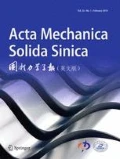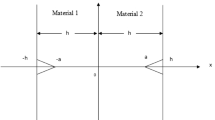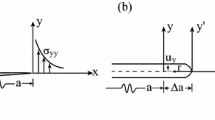Abstract
In this paper interfacial edge crack problems are considered by the application of the finite element method. The stress intensity factors are accurately determined from the ratio of crack-tip-stress value between the target given unknown and reference problems. The reference problem is chosen to produce the singular stress fields proportional to those of the given unknown problem. Here the original proportional method is improved through utilizing very refined meshes and post-processing technique of linear extrapolation. The results for a double-edge interface crack in a bonded strip are newly obtained and compared with those of a single-edge interface crack for different forms of combination of material. It is found that the stress intensity factors should be compared in the three different zones of relative crack lengths. Different from the case of a cracked homogeneous strip, the results for the double edge interface cracks are found to possibly be bigger than those for a single edge interface crack under the same relative crack length.
Similar content being viewed by others
References
Williams, M.L., Stress singularities resulting from various boundary conditions in angular corners of plates in extension. Journal of Applied Mechanics, 1952, 19: 526–528.
Hein, V.L. and Erdogan, F., Stress singularities in a two-material wedge. International Journal of Fracture Mechanics, 1971, 7: 317–330.
Bogy, D.B. and Wang, K.C., Stress singularities at interface corners in bonded dissimilar isotropic elastic materials. International Journal of Solids and Structures, 1971, 7: 993–1005.
Dempsey, J.P. and Sinclair G.B., On the stress singularities in the plane elasticity of the composite wedge. Journal of Elasticity, 1979, 9: 373–391.
Van Vroonhoven, J.C.W., Stress singularities in bi-material wedges with adhesion and delamination. Fatigue and Fracture Engineering Materials and Structures, 1992, 15: 157–171.
Bogy, D.B., Two edge-bonded elastic wedges of different materials and wedges angles under surface tractions. Journal of Applied Mechanics, 1971, 38: 377–386.
Vasilopoulos, D., On the determination of higher-order terms of singular elastic stress fields near corners. Numerical Mathematics, 1988, 53: 51–59.
Theocaris, P.S., The order of singularity at a multi-wedge corner in a composite plate. International Journal of Engineering Science, 1974, 12: 107–120.
Dempsey, J.P. and Sinclair, G.B., On the singular behavior at the vertex of a bi-material wedge, Journal of Elasticity, 1981, 11: 317–327.
Wu, Y.L., A new method for evaluation of stress intensities for interface cracks. Engineering Fracture Mechanics, 1994, 48: 755–761.
Yang, X.X. and Kuang, Z.B., Contour integral method for stress intensity factors of interface crack. International Journal of Fracture, 1996, 78: 299–313.
Munz, D. and Yang, Y.Y., Stress singularities at the interface in bonded dissimilar materials under mechanical and thermal loading. Journal of Applied Mechanics, 1992, 59: 857–861.
Dong, Y.X., Wang, Z.M. and Wang, B., On the computation of stress intensity factors for interfacial cracks using quarter point boundary elements. Engineering Fracture Mechanics, 1997, 57: 335–342.
Liu, Y.H., WU, Z.G., Liang Y.C. and Liu, X.M., Numerical methods for determination of stress intensity factors of singular stress field. Engineering Fracture Mechanics, 2008, 75: 4793–4803.
Oda, K., Kamisugi, K. and Noda, N.A., Analysis of stress intensity factor for interface cracks based on proportional method. Transactions of Japan Society of Mechanical Engineers, Series A, 2009, 75: 476–482.
Teranishi, T. and Nisitani, H., Determination of highly accurate values of stress intensity factor in a plate of arbitrary form by FEM. Transactions of Japan Society of Mechanical Engineers, Series A, 1999, 65(635): 16–21.
Noda, N.A., Lan, X., Michinaka, K., Zhang, Y. and Oda, K., Stress intensity factor of an edge interface crack in a bonded semi-infinite plate. Transactions of Japan Society of Mechanical Engineers, Series A, 2010, 76(770): 1270–1277.
Lan, X., Noda, N.A., Michinaka, K. and Zhang, Y., The effect of material combinations and relative crack size to the stress intensity factors at the crack tip of a bi-material bonded strip. Engineering Fracture Mechanics, 2011, 78: 2572–2584.
Erdogan, F., Stress distribution in bonded dissimilar materials with cracks. Transactions of ASME, Journal of Applied Mechanics, 1965, 32: 403–410.
Kaya, A.C. and Erdogan, F., On the solution of integral equations with strongly singular kernels. Quarter of Applied Mathematics, 1987, 45(1): 105–122.
Noda, N.A., Araki, K. and Erdogan, F., Stress intensity factors in two bonded elastic layers with a single edge crack under various loading conditions. International Journal of Fracture, 1992, 57: 101–126.
Nisitani, H, Chen, D.H. and Samimoto, A., Versatile Program of Two-Dimensional Stress Analysis Based on Body Fore Method. Tyoko: Baifukan, 1994 (in Japanese).
Matsumto, T., Masataka, T. and Obara, R., Computation of stress intensity factors of interface cracks based on interaction energy release rates and BEM sensitivity analysis. Engineering Fracture Mechanics, 2000, 65: 683–702.
Yuuki, R. and Cho, S.B., Efficient boundary element analysis of stress intensity factors for interface cracks in dissimilar materials. Engineering Fracture Mechanics, 1989, 34: 179–188.
Ikeda, N., Soda, T. and Munakata, T., Stress intensity factor analysis of interface crack using boundary element method—Application of contour-integral method. Engineering Fracture Mechanics, 1993, 45: 599–610.
Chen, D.H. and Nishitani, H., Intensity of singular stress field near the interface edge point of a bonded strip. Transactions of Japan Society of Mechanical Engineers, Series A, 1993, 59: 2682–2686.
Reedy, Jr., Asymptotic interface-corner solutions for butt tensile joints. International Journal of Solids and Structures, 1993, 30: 767–777.
Author information
Authors and Affiliations
Corresponding author
Rights and permissions
About this article
Cite this article
Lan, X., Noda, NA., Zhang, Y. et al. Single and Double Edge Interface Crack Solutions for Arbitrary Forms of Material Combination. Acta Mech. Solida Sin. 25, 404–416 (2012). https://doi.org/10.1016/S0894-9166(12)60036-6
Received:
Published:
Issue Date:
DOI: https://doi.org/10.1016/S0894-9166(12)60036-6




